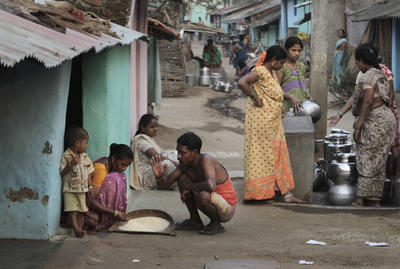The Millennium Development Goals — when aiming to eliminate poverty and extreme poverty — set the benchmark at the IPL, currently estimated at US$2 per day for poverty and US$1.25 per day for extreme poverty. But this fails to distinguish among groups — women, men, children, elderly, the vulnerable — and marginalised groups and also excludes multi-dimensional deprivations.
When it comes to debates about poverty measurement, feminists in development have much to bring to the table. Longstanding feminist contributions to the analysis of poverty have always been about critiquing the household as the unit of analysis — it is oblivious to personal identities of gender, age and position in the household. It ignores the different and often conflicting preferences, needs and interests of different members in a given household.
The Multidimensional Poverty Index (MPI) comes somewhat closer in offering an alternative to income-based measures, as it is underpinned by Amartya Sen’s capabilities approach, which emphasises the capability of individuals to live what they would consider to be a ‘good life’. The MPI is an index of multidimensional poverty measured at the household level. It uses ten indicators, including health, education and standard of living. Still, the MPI does not go far enough when it comes to gender sensitivity in poverty measurements. The MPI is gender-blind. It fails to accurately capture both the prevalence of poverty among women as compared to men, and the complex lived realities of women and men who experience poverty beyond household-level averages.
The Individual Deprivation Measure (IDM), a feminist research project at the Australian National University, was made to address these challenges. It is the first to measure poverty of individuals rather than households, and is based on how poor women and men define poverty. So why use the IDM? And how will it assist development policymakers and planners in the Asia Pacific region?
The usefulness of the IDM as a measure of poverty depends on the quality of the data upon which it is built, the transparency with which it was developed, and its ability to better inform policy. For a start, the IDM uses both qualitative and quantitative assessments of poverty. It uses participatory research by talking to and with people in poor communities in 18 sites across six countries: Fiji, Indonesia, the Philippines, Angola, Malawi and Mozambique.
By talking to individual women and men who experience and live with poverty, the IDM methodology immediately departs from existing household-level measures of poverty. For the first time, academics are actually learning from poor people how they define poverty and how they assess if someone is poor. The IDM reveals individual experiences of poverty and inequality within households.
The IDM certainly offers more to the plate than existing measures, which are often constrained by limited data sources such as income or expenditure. It is grounded in academic and policy discourse on definitions and measurements of poverty, but takes the theory one step further by taking the priorities of the poor into consideration.
The measure not only drew attention to gender differences in priorities expressed by poor people, but also differences reflecting the gender roles and responsibilities assigned by households and communities. For instance, significantly more women than men prioritised cooking fuel and personal care as important for determining whether a person experiences poverty or not, reflecting the hardships faced by women in domestic circumstances. Based on what poor women and men considered important in defining poverty, the project then developed a measure of deprivation comprising the 15 dimensions most common across sites and countries.
The IDM was piloted in the Philippines, and revealed differences in individual levels of deprivation within the household, based on gender, generation and location. The IDM also offers a unique gendered poverty analysis by including dimensions such as family relations, freedom from violence, voice in the community, use of time, caring and household labour burdens, and participation in economic activity (paid and unpaid work).
Seeing poverty through a gender lens is a crucial element in analysing and tracking it more effectively. The IDM offers some hope for the Pacific region. Fiji is leading the way as the first country in the region to undertake a multi-topic individual and household survey using the IDM approach. Collecting data at the individual level will not only tell a deeper and richer story about how women and men experience poverty, but will also capture information on the key dimensions of life that poor women and men value as important.
The United Nations has set inequality as one of the foci of the post-2015 development agenda. If this is to be effectively addressed, it is important that gender-sensitive data reflecting the gender-based challenges and deprivations faced by individual women and men is used to design women’s empowerment programs.
Priya Chattier is a research fellow in The State Society and Governance in Melanesia Program, Coral Bell School of Asia Pacific Affairs, The Australian National University.

